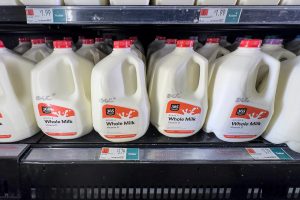
The House of Representatives has scheduled a vote for the new trade deal, the United States-Mexico-Canada Agreement, or USMCA, for today. Negotiations for a new deal to replace the North American Free Trade Agreement, or NAFTA, began in January of 2017, after President Donald J. Trump took office. The leaders of all three countries signed the deal in November of 2018, and it awaits final approval from lawmakers.
The office of the U.S. Trade Representative Robert Lighthizer previously claimed “increasing dairy market access” in Canada, particularly by providing newer, larger quotas for U.S. dairy products and eliminating controversial barriers against dry milk powder products, as one of the deal’s key achievements.
While agriculture stakeholders want the new deal passed to support the dairy industry, they claim it will yield a small improvement for U.S. dairy outside of trade and market stabilization between the three countries.
“The components of this revised NAFTA reflect a lot of what was already in the original NAFTA, and some portions were exhibited in the TPP (Trans Pacific Partnership)” said Andrew M. Novakovic, agriculture economist and professor at Cornell University, Ithaca. “It’s a positive effect on dairy … but the positive effect will be small.”
The new deal allows U.S. producers to export more fluid milk, cheese, butter, yogurt and other dairy products into Canada, each one from hundreds to thousands of metric tons by year six from adoption.
The amount of exports for each product will increase one percent for an additional 13 years except for whey, which will experience a one percent increase for an additional four years and the elimination of its over-quota tariff in 10 years, and margarine, the tariff of which will be eliminated in five years.
Experts from the Brookings Institution, a Washington, D.C., nonprofit that conducts in-depth research on policy, claim the new deal will increase U.S. market share in Canadian dairy products from three percent to 3.59 percent before triggering tariffs. The cumulative effect of the deal results in allowing the U.S. to “expand its sales to Canada by less than one percent of Canadian sales – or about 20 percent of current U.S. exports to Canada and about 0.2 percent of total U.S. dairy industry revenues,” according to a 2018 report from Brookings.
For example, the U.S. will be able to export 50,000 more metric tons, or 110 million pounds, of fluid milk to Canada by year six of the new agreement, if approved. Mr. Novakovic, however, said of the 220 billion pounds of milk and dairy products produced in the U.S., the uptick accounts for 0.05 percent of U.S. dairy production, or 0.02 percent dedicated to fluid milk.
“These shares that go into Canada are just not that big,” he said, adding that Canadian producers will also have access to U.S. markets for their exports.
Steve Ammerman, public affairs manager for New York Farm Bureau, said while the gains for the overall U.S. dairy industry are “not dramatic,” they still provide a benefit to producers, particularly by allowing them to ship more product to Canada. By increasing imports to Canada, Mr. Ammerman said more product leaves the market, which could raise milk prices, and therefore revenue, for U.S. dairy farmers.
“This needs to get ratified. While it’s important to the dairy industry, it’s very important because it reaffirms that markets to the U.S. and Canada remain open,” Mr. Ammerman said. “The more milk that can get off the market, the more we can boost the (milk) price. This has the potential to benefit every dairy farmer.”
The agreement, if adopted by all three countries, would eliminate price classes from Canada that govern skim milk solids, or milk powder, products that are used to make nonfat dry milk, infant formula and milk protein concentrates, thus helping open Canadian markets for these products to U.S. producers.
Farmers and lawmakers have claimed that when Canada adopted class 6 and 7 prices years ago, it inhibited their ability to sell milk powder products to Canadian consumers through tariffs. The pricing structure also allowed Canadian producers to sell their milk powder products at cheaper prices than U.S. products.
The new deal, however, would ensure Canadian prices “will be set no lower than a level based on the United States price for nonfat dry milk,” according to the office of the trade representative.
The elimination of Canadian class prices involved with milk powder products could help generate millions of dollars for processors like O-AT-KA Milk Products Cooperative, Batavia, and Cayuga Milk Ingredients, Auburn, that make them, Mr. Ammerman said. When asked whether the elimination of class 6 and 7 pricing would open more trade opportunities to milk powder products, Mr. Novakovic said “maybe.”
Ronald C. Robbins, owner of North Harbor Dairy in Hounsfield, said sales for every type of dairy product affects the blend price, which influences overall revenue farmers receive for their milk, and the drop in demand for milk powder products in recent years from China caused a dip in U.S. prices for farmers’ milk. Opportunities to export more of those products to Canada as a result of the new deal could help raise the blend price, Mr. Robbins said. Outside of products made with milk powder products, however, Mr. Robbins said he does not “think it will have a big impact,” for U.S. dairy farmers’ ability to export products to Canada.
“Any new trade opportunity is certainly going to be helpful,” he said.
The new trade deal also will preserve trade relations with Mexico, a vital partner for U.S. dairy farmers. When the U.S. previously instituted tariffs on Mexican aluminum and steel, Mexico retaliated with its own tariffs on U.S. cheese. The new tariffs from Mexico and China combined caused a $2.3 billion revenue loss for U.S. dairy producers as of March, according to the National Milk Producers Federation, resulting in lower milk prices for farmers.
Catherine deRonde, senior economist for the dairy cooperative Agri-Mark, said preserving a trade relationship with Mexico, a top trade partner that imported more than $1 billion in dairy goods from the U.S. last year, serves as a crucial benefit for the industry. No deal could have also provided European producers the opportunity to claim U.S. market share in Mexico, she said.
While short-term benefits of the new trade deal for U.S. dairy producers would be minimal outside of maintaining a relationship between the U.S. and Mexico, Ms. deRonde said should the U.S. increase production, Mexico could serve as an outlet for additional exports.
“Let’s do whatever we can to get this into place,” she said.

























